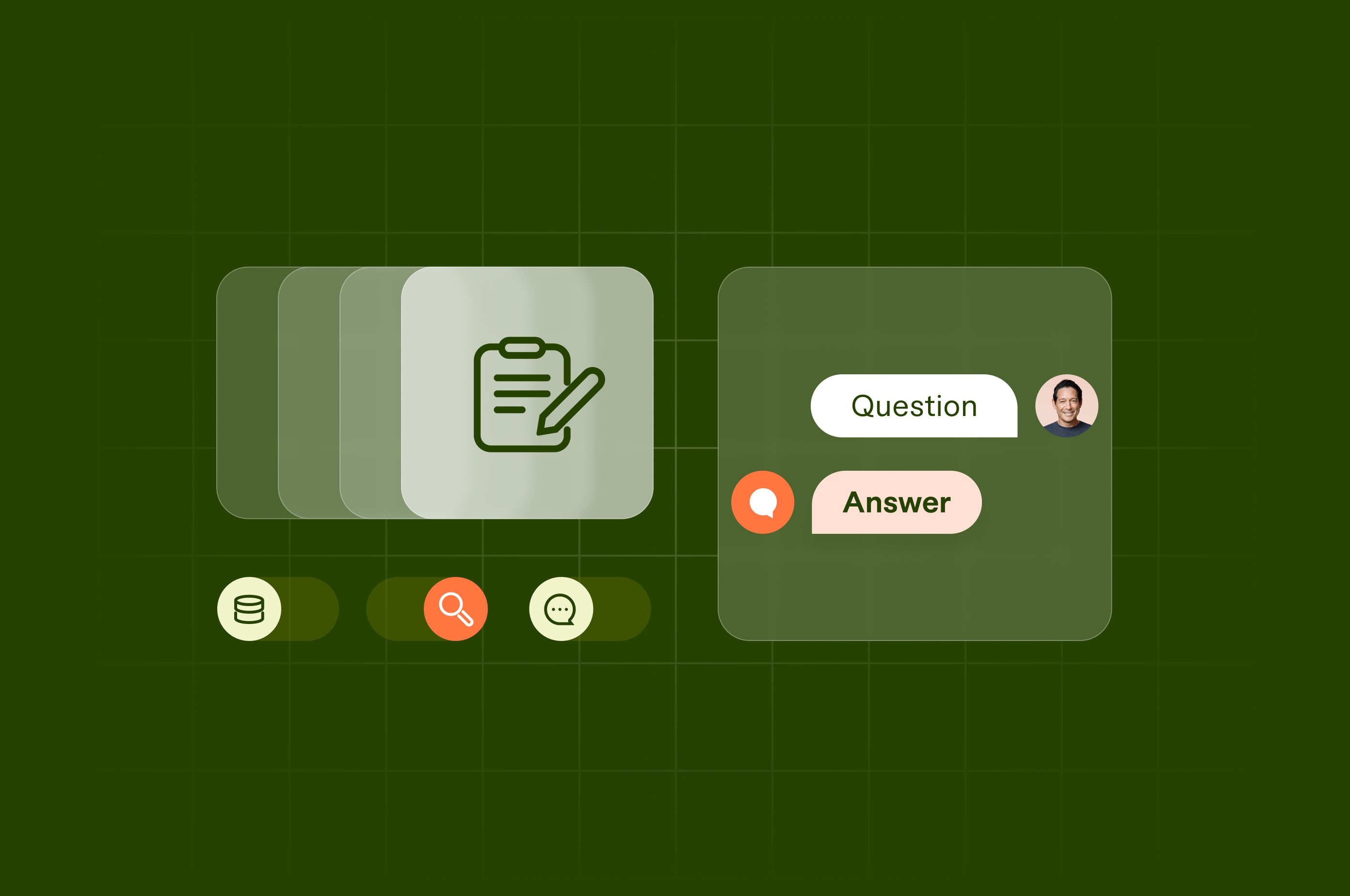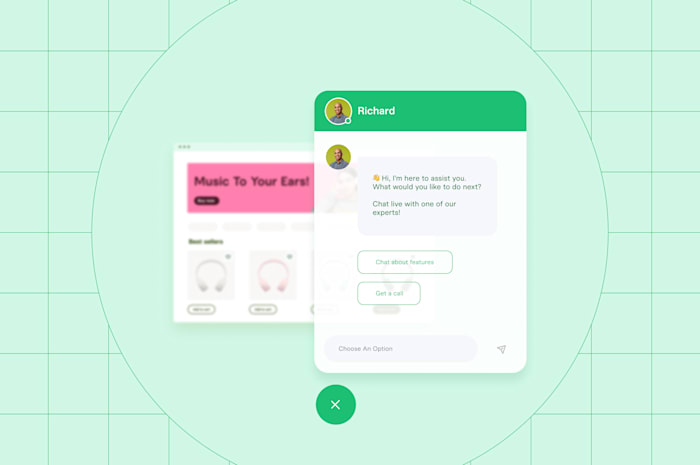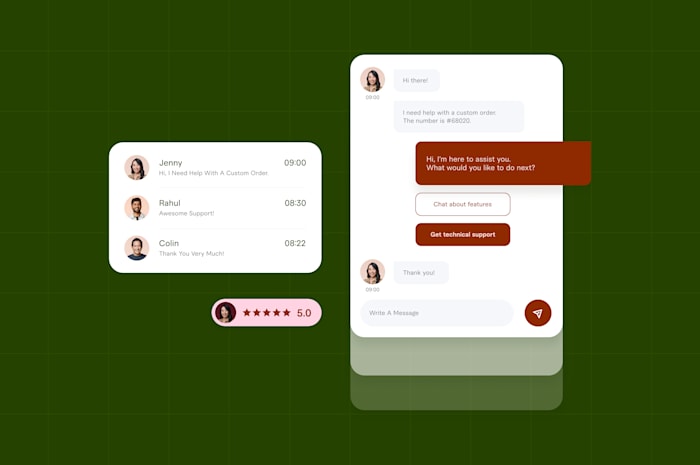The 10 Best AI Models To Use for Building a Conversational Chatbot in 2024
Discover the 10 best AI models to build a chatbot. Build your own today with the help of a freelancer.
 December 7, 2023
December 7, 2023 9 minute reading
9 minute reading
Customer expectations are high—53%of online shoppers say waiting too long for replies is the most frustrating part of interacting with businesses.
One way small and midsize businesses (SMBs) are tackling this issue (without hiring more resources): deploying conversational chatbots. Using artificial intelligence (AI) to create sophisticated chatbots to be developed and solve customer support pain points with automation.
In this guide, we’ll cover what a chatbot is and what the most popular AI models are for building one.
What is a chatbot?
Chatbots mimic and process human conversations over text or voice. Many prefer them over virtual assistants because they streamlineworkflows and can process large amounts of data faster than human intelligence. In this case, AI systems have more efficient decision-making skills.
Chatbots often have AI models with deep learning techniques and machine learning algorithms so it can complete specific tasks. You can deploy them on different platforms like Discord or social media. Great examples of an intelligent chatbot include Amazon’s Alexa, Meta’s Meta AI, and Microsoft’s Bing chatbot.
Over 100 million users have Open AI’s ChatGPT. GPT-3 was an exciting advancement for AI, but GPT-4 further demonstrates how advanced generative AI is and even offers APIs. Chatbots like ChatGPT, powered by transformer-based large language models (LLMs), show the kind of chatbot you can build.
Learn how to talk to ChatGPT, train it using your business data, and what plugins you can add.
Chatbots
1. Linear regression
The concept of linear regression isn’t new—it’s been around since the 19th century and its use in AI models is growing. A linear regression model predicts unknown data by relying on available data. Businesses employ linear regression models to make data-driven predictions and adjust strategies accordingly.
Use cases
There are several use cases for linear regression models, including:
Analyzing relationships
Discovering emerging trends
Predicting outputs based on inputs
How does it work in a conversational chatbot?
Linear regression models are predictive, so they make great building blocks for conversational chatbots. First, the chatbot needs training with relevant data. Then it analyzes customer questions in real-time, using that information to predict subsequent questions and prepare the right responses.
2. Deep neural networks
Deep neural networks (DNN) are inspired by the human brain, making it a complex and layered machine learning model. DNN contains many layers, unlike shallow models consisting of just a few. It operates at an advanced level, not simple input and output procedures.
Use cases
DNN enables technology to take on human tasks without compromising quality.
Here are a few use cases for the model:
Pattern recognition
Facial recognition
Natural language processing (NLP)
How does it work in a conversational chatbot?
SMBs today use various chatbots to grow and scale with DNN being a common model for more complex, advanced conversational chatbots. DNN goes beyond responding based on keywords, it can analyze customers’ sentiments and craft a response that takes into account emotions. It can better mimic human language, making it a top choice for businesses wanting to build a standout chatbot.
3. Decision trees
This is one of the most dated AI models because it’s easy to understand, and is effective at handling regression and classification problems. The model functions as a binary, and comes up with responses based on an if/then structure. It’s programmed with result nodes and continues splitting based on responses until it reaches one of the outcomes.
Use cases
While decision trees aren’t the ideal choice for advanced tasks, they’re well-equipped to handle basic things, like:
Personalize recommendations
Detect anomalies
Classify and highlight information
How does it work in a conversational chatbot?
As chatbots continue to advance, limiting decision trees models are being left behind. Still, it’s a great choice for businesses building rule-based chatbots. The AI model can select the appropriate predetermined response based on what the customer says. It also can help drive customers to the appropriate response department.

Example of a decision tree being used for rain forecasting. Source
4. Logistic regression
If you’re looking for binary results, logistic regression is another optimal AI model. It looks at a variety of factors to come to a “yes” or “no” result. This information is especially helpful for businesses looking to analyze and predict customer behavior.
Use cases
Logistic regression is only useful for binary classification, so its limited use cases are mainly in marketing and healthcare, such as:
Identify customer retention
Predict customer churn
Diagnose medical conditions
How does it work in a conversational chatbot?
When you need NLP , logistic regression isn't the best choice for advanced conversational chatbots. For rule-based or menu-based chatbots, it’s a good AI model to use. It’s still useful when figuring out the intent of a customer’s query or choosing the correct predetermined response.
5. Linear discriminant analysis
Linear discriminant analysis exists as a branch of the logistic regression AI model. But, it involves results that contain two different classes as the output. So it can take on more than just classification problems, which is what the logistic regression model is limited to. Linear discriminant analysis handles classification and regression issues by averaging the results found from numerous decision trees.
Use cases
A more advanced version of the logistic regression model, linear discriminant analysis can produce more than a binary result.
Here are example use cases:
Perform quality control
Diagnose medical conditions
Perform facial and speech recognition
How does it work in a conversational chatbot?
Linear discriminant analysis can build a rule-based or keyword-based conversational chatbot for. It doesn't incorporate NLP, but is still useful for SMBs launching chatbots to answer generic customer inquiries.

Before and after example showing linear discriminant analysis model. Source
6. Naive Bayes
Based on the Bayes Theorem, the Naive Bayes AI model is interesting because it functions on the idea that all input data isn’t related. While this is a hard concept to prove in reality, it applies well to data flows. Multiple-class and binary classifications use Native Bayes.
Use cases
Naive Bayes is best for classification, so its use cases revolve around tasks like:
Detecting emails as spam
Analyzing customer feedback
Categorizing documents and conversations
How does it work in a conversational chatbot?
Train your Naive Bayes chatbot with a variety of questions and appropriate responses so it can identify and label conversations and provide the correct response. Create an effective Naive Baye chatbot in python and collaborate with prompt engineers to program the chatbot to answer questions in an appropriate tone.
7. Support vector machine
The potential that the support vector machine model possesses intrigues data scientists because it offers a powerful approach to data classification. AI algorithms aid data analysis, with the support vector machine as a prime example.
This supervised learning model finds the optimal hyperplane that best separates data points of different classes. For example, if you had data about different articles of clothing, it could draw a line separating shirts from pants.
Use cases
Data science isn’t the only use case, various real-world examples of the support vector machine algorithms benefiting SMBs exist.
Here are some use cases:
Detecting outliers
Using computer vision
Performing regression problems
How does it work in a conversational chatbot?
The support vector machine model is precise, making it an optimal choice for a conversational chatbot. It mimics human language and tone well, meaning customers might not realize they’re talking with a bot.
8. K-nearest neighbor
K-nearest neighbor is a supervised ML model that’s primarily for regression and classification tasks. It operates on the assumption that similar information clusters and is useful for large data sets. However, it it slows down the larger the data volume is.
Use cases
Various industries—from healthcare to finance to data science—use this model for AI tools.
Use cases vary, but there are a few examples:
Recommending products
Detecting anomalies
Predicting patient outcomes
How does it work in a conversational chatbot?
One advantage of K-nearest neighbor is it handles vast training data. As it learns from all the data, it becomes more intelligent and personalized with its responses over time. Not all AI chatbots can handle this, but K-nearest neighbor makes sure that yours can. Then, work with an AI prompt writer to fine-tune your chatbot’s language.

Before and after example of data with K-nearest neighbor model. Source
9. Learning vector quantization
Learning vector quantization is an advanced version of K-nearest neighbor. It’s an artificial neural network model solving multi-class classification issues. It locates vectors with the most similar values to predict the most accurate output.
Use cases
The use cases for learning vector quantization are similar to those of K-nearest neighbor. But since it’s more advanced, the use cases are for more complex tasks.
These are some use cases:
Recognizing patterns
Classifying structured data
Labeling customer intent
How does it work in a conversational chatbot?
The learning vector quantization model only requires a smaller subset of training data, making it superior to K-nearest neighbor. It’s a great building block for a conversational chatbot because it has fantastic accuracy, allowing it to properly gauge and respond to customers.
10. Random forest
Remember decision trees? Random forest combines a bunch of them and aggregates the results to obtain a more accurate prediction. Individuals who enjoy relying on a decision tree as an AI model can find greater precision with random forestAI technology.
Use cases
The use cases for random forest are similar to the use cases for decision tree, but the predictions are more accurate.
Here are some examples:
Predicting stock prices
Identifying important features
Recognizing patterns
How does it work in a conversational chatbot?
Chatbots built with the random forest algorithm have higher response quality since they better understand customers’ intent and queries. Their predictive analytics are greater than some of the other AI models, especially for conversational chatbots.

Diagram of a random forest AI model with three separate decision trees. Source
How to add a conversational chatbot to your business
Complete beginners can build a chatbot with open-sourceframeworks and languages—like TensorFlow or GitHub and Python—it’s better to invest in professional help. The most effective chatbots will use deep learning models, which require more knowledge about AI and programming.
As you go add a conversational chatbot to your business, follow this step-by-step checklist:
Evaluate your business requirements to determine the most suitable AI model for your chatbot
Implement the selected AI model within your existing communication channels
Customize the chatbot's responses and functionalities to align with your specific customer needs
Monitor the chatbot's performance and interactions, making necessary adjustments for optimization
Integrate the chatbot seamlessly with your current online ecosystem
Engage with your customers to gather feedback and insights for continuous improvement
Now that you know what the top AI models are and what steps to take to implement a conversational chatbot, what are you waiting for?
Join Fiverr and access a marketplace of talented freelancers who specialize in everything from AI consulting to chatbot development to chatbot conversation scripts. Consider integrating AI with your business needs even further and partner with an AI artist skilled in DALL-E or Diffusion, or get help developing your own AI application.



